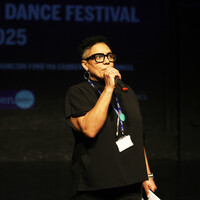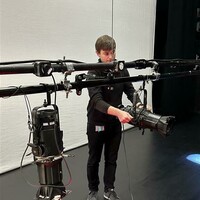Tue 7 June: Hsing Ya Wu/Hannah Grace/Emma Stanworth

News Story
Hsing Ya Wu Black & White
Hannah Grace Sacred Awakening: This Is Not My skin
Emma Stanworth th\ud
Sitting in the round enabled multi- perspectival viewing for each of tonight’s identity questioning works. For Hsing Ya Wu this was an emotional searching for her Taiwanese roots and a personal coming to terms with her clashing East/West influences. There’s a lightness in her fast, fluid, lyrical movement, hampered only by an orange balloon attached to her face. I understand the balloon as a metaphor of happiness and longing, her nostalgia for her beautiful island, traced through articulate hand gestures and traditional Taiwanese music. When the balloon pops, a moody darkness and unease descend on the stage, enhanced by Stefano Ancora’s atmospheric live percussion and Hsing Ya's desperate, crawling floor work. But like a phoenix she rises up in the face of change and throws herself passionately into a deeply emotive dance- in possession of her different cultural identities, if not her sanity.
Hannah Grace and Jacquelyn Tepper erupt in sequences of punishing boot-camp exercises. Anger fuels their resilience as they dive into the floor, hurl themselves at each other or balance in precarious press-ups. But all is not ok – there’s a subtext of sexual violence and a visceral need to shake off the sense that their bodies are receptacles for male desire and sexual invasion. To hard-core techno music, they convulse, thrust, gyrate in grotesque sexual references. There’s no pleasure here – only pain. What makes the duet work for me is how they embody a close, female solidarity throughout with gentler, caressing interactions, while their soft singing at the end suggests a reclaiming of their bodies.
Emma Stanworth’s th\ud brings calmer waters – literally in a group work that explores the confluence of tides as a stimulus for thinking about how we encounter each other. Serene and composed, the five women meet on stage or as they walk diagonally across it in various configurations: sometimes solo, or in twos and threes. Inspired by the dynamics of water as it confronts the rocks, when they gather together they move in circular patterns and phrases, making contact or sharing weight. Mesmeric and with integrity, the performers reveal other ways of connecting that ellude heterosexual predictability.
Josephine Leask
Beginning in serenity with spacious vocals, Hsing Ya Wu glides across the space, suggesting delicacy with fluidity as Michael Picknett’s soft squares of light race to catch up with her. Stefano Ancora sets the scene with ambient sounds before live drumming kicks in, becoming more intense as Hsing Ya writhes in emotional descent. A helium balloon covers her face, contrasting her restless orientation in its attempts to find verticality. Its pop is a tension-breaking climax that collapses Hsing Ya, who crawls slowly towards light. She eventually stands with a pained facial expression, and I can’t help but feel sorry for her. Through considered costume, music, props and movement qualities, Black & White expresses a fragmented cultural identity and makes me question my viewpoint as a white western man.
SACRED AWAKENING: This Is Not My Skin isn’t the most comfortable of watches. Two dancers vibrate as they sing a rendition of On I Go by Fiona Apple, and Hannah Grace builds to an impressively excessive pitch and volume that makes me wince on the front row. Her statement is clear: they’re not here to please. The vibrations continue to upbeat music, which inspires fitness routines, twerking and self-touching. They scream as they struggle through the choreography, but this isn’t as arresting as the opening vocals. Later, they scream more, crawling and squirming in pain and desperation, but it doesn’t quite connect. Animalistic growling morphs into crying and I’m reminded of PTSD. Perhaps the disconnection between the audience and their pain is a deliberate representation of their own dissociation.
Emma Stanworth’s th\ud begins unannounced in the spillover from the house lights. Dressed in blue to represent water, the five dancers are the biggest group I’ve seen so far at Resolution, but the patterns and pathways they trace are still limited by their number. While it has the basis of an interesting idea, the work might be more effective as an installation with more performers. As a dance piece in a fixed theatre setting, it lacks highlights, contrasts, ups and downs to command attention.
Luke Hodkinson


